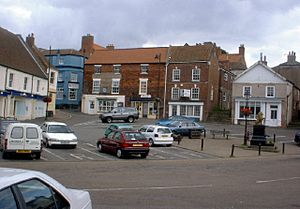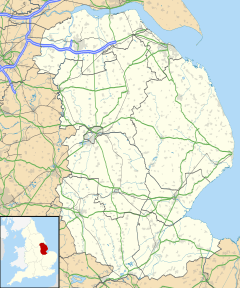Caistor facts for kids
Quick facts for kids Caistor |
|
|---|---|
 Caistor Market Place |
|
| Population | 2,601 (2001) |
| OS grid reference | TA1101 |
| • London | 135 mi (217 km) S |
| Civil parish |
|
| District |
|
| Shire county | |
| Region | |
| Country | England |
| Sovereign state | United Kingdom |
| Post town | MARKET RASEN |
| Postcode district | LN7 |
| Dialling code | 01472 |
| Police | Lincolnshire |
| Fire | Lincolnshire |
| Ambulance | East Midlands |
| EU Parliament | East Midlands |
| UK Parliament |
|
Caistor is a small town and local area in the West Lindsey district of Lincolnshire, England. Its name tells us it was once a Roman castrum, which means a fort or military camp. Caistor is located on the north-west edge of the Lincolnshire Wolds, a beautiful area of rolling hills. It's also found on the Viking Way, a long-distance walking path. The town is just off the A46 road, which connects Lincoln and Grimsby. In 2001, Caistor had a population of 2,601 people. The name Caistor comes from the Old English word ceaster, meaning "Roman camp" or "town". In the Domesday Book of 1086, it was called Castre.
Contents
Discovering Caistor
Ancient Buildings and History
Only a few parts of the original 4th-century Roman walls are still standing today. For example, you can see a piece of the old Roman wall on the southern side of the parish church of St Peter and St Paul. The entire area where the Roman fort once stood is now a scheduled monument, meaning it's a protected historical site.
The church of St Peter and St Paul is built inside the old fort area and has an Anglo-Saxon tower, which means it's very old! The market square is the heart of Caistor and is part of a conservation area. This means the area has special historical importance. There are 56 listed buildings here, mostly from the Georgian or Victorian times. These buildings are protected because of their history and special design. Caistor has the most listed buildings in the West Lindsey area.
In 2010, during the building of a new supermarket, archaeologists found the remains of a Roman cemetery from the 4th century. This shows how much history is hidden beneath the town!
Learning in Caistor
Caistor is home to two important schools that help young people learn and grow.
Caistor Grammar School
Caistor Grammar School is a very old school, started during the time of King Charles I. It's an academy where students need to pass a test to get in. The school is known for its focus on sports and humanities (subjects like history and literature). A famous author named Sir Henry Newbolt, who wrote the poem Drake's Drum, went to this school.
Caistor Yarborough Academy
Caistor Yarborough Academy is a mixed school for both boys and girls. It's named after John Edward Pelham, the 7th Earl of Yarborough. This school is smaller than many others in Britain, with about 570 students. It has a special focus on the arts. In 2012, the school became an Academy, which means it's funded directly by the government.
Caistor's Airfield Past
RAF Caistor was an airfield that opened in 1940 during World War II. It was first used as a backup airfield for RAF Kirton in Lindsey and for training pilots on its grass runways. The airfield closed in 1945.
Later, between 1959 and 1963, RAF Caistor was used as a base for Thor missiles. These were large rockets. Today, the land has gone back to being used for farming, and there isn't much left of the old military base.
Getting Around Caistor
The closest train station to Caistor is Barnetby railway station. Caistor used to have its own train stations at North Kelsey and Moortown, but these are now closed. The old station buildings are now private homes.
The town has bus services that can take you to nearby places like Brigg, Grimsby, Market Rasen, and Lincoln. These buses are run by Stagecoach.
Humberside Airport is also a short distance north of Caistor, making it easy to travel further afield by plane.
Local Media
If you live in Caistor, you can get television signals from either the Emley Moor or Belmont TV towers.
For radio, you can listen to local stations like BBC Radio Humberside, Hits Radio East Yorkshire & North Lincolnshire, Hits Radio Lincolnshire, and Greatest Hits Radio East Yorkshire & Northern Lincolnshire.
The town's local newspaper is the Grimsby Telegraph.
Nearby Hamlets: Audleby and Fonaby
Audleby
Audleby is a small village or hamlet located just north of Fonaby. It was mentioned in the Domesday Book as a fairly large settlement with 33 households. Today, Audleby is known as a deserted medieval village (DMV), meaning it's a village that no longer exists as it once did. Audleby House on Brigg Road is a Grade II listed building, meaning it's an important historical building.
Fonaby
Fonaby is another hamlet and deserted medieval village just north of Caistor. The Domesday Book also mentioned Fonaby, saying it had 18 households and three acres of meadow. It was owned by William I. Today, Fonaby has three farms and one other house. One of the farms and the house are located along the old Viking Way.
Famous Faces from Caistor
- Admiral Nigel Malim, a high-ranking naval officer, lived in Caistor.
- Gary Turner, a sideshow performer who holds a World Record, was born in Caistor.
An Old Local Story
According to a local tradition, one of Jesus's 12 apostles, Simon the Zealot, might have come to England. The story says he was killed near Caistor on May 10, AD 61, on the orders of a Roman official named Catus Decianus. He was supposedly put to death in a way similar to crucifixion. However, there are other ideas about what happened to Simon the Zealot. This is just a local story passed down through time.
See also
 In Spanish: Caistor para niños
In Spanish: Caistor para niños


